Some Impossibly Beautiful Needlework
Before Breakfast: Interview with Illustrator
Salley Mavor (the Winter Blog Blast Tour Edition)
 December 7th, 2010 by jules
December 7th, 2010 by jules
{Quick note for any newbies: Blog blast tours are when many children’s-book bloggers interview children’s and YA book authors over the course of a week, following one huge master schedule—which I’ve included at the bottom of this post—and we all get very link-happy and post about one another’s interviews in an effort to spread the word about great books. Enjoy.}
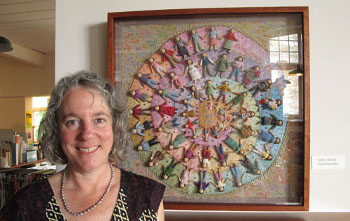 This September, illustrator and creator-of-beautiful-images, Salley Mavor, brought readers A Pocketful of Posies: A Treasury of Nursery Rhymes (Houghton Mifflin), and it truly is one of the most outstanding picture books you’ll see this year (in my enthusiastic opinion). A 64-page volume of classic nursery rhymes, Salley painstakingly and stunningly rendered all of the illustrations in needlework, what she calls her fabric relief collage. And it’s a jaw-dropper of a picture book. If you haven’t seen Salley’s work before now, let this be the first book of hers you see. “Rarely have classic childhood verses been depicted with so much care and detail — and fabric,” wrote Publishers Weekly. “Loosely organizing the rhymes over the course of the day, starting with morning themes and closing with bedtime rhymes, Mavor creates a miniature world using wool felt, various stitching techniques, and found materials like acorn caps and seashells… Mavor’s intricate and colorfully embroidered work of art makes even the best-known childhood poems feel special and new again.”
This September, illustrator and creator-of-beautiful-images, Salley Mavor, brought readers A Pocketful of Posies: A Treasury of Nursery Rhymes (Houghton Mifflin), and it truly is one of the most outstanding picture books you’ll see this year (in my enthusiastic opinion). A 64-page volume of classic nursery rhymes, Salley painstakingly and stunningly rendered all of the illustrations in needlework, what she calls her fabric relief collage. And it’s a jaw-dropper of a picture book. If you haven’t seen Salley’s work before now, let this be the first book of hers you see. “Rarely have classic childhood verses been depicted with so much care and detail — and fabric,” wrote Publishers Weekly. “Loosely organizing the rhymes over the course of the day, starting with morning themes and closing with bedtime rhymes, Mavor creates a miniature world using wool felt, various stitching techniques, and found materials like acorn caps and seashells… Mavor’s intricate and colorfully embroidered work of art makes even the best-known childhood poems feel special and new again.”
“Working on Pocketful of Posies was a lengthy (three years), but joyful, experience,” Salley tells me. Salley—who received her BFA from Rhode Island School of Design in 1978—is joining me for breakfast this morning in this Winter Blog Blast Tour interview edition. (Again, see the bottom of this post for the rest of the week’s interview schedule.) We’re dining on her breakfast-of-choice this morning, and that would be hard-boiled eggs, yogurt, granola, and fruit, which I am very much down with. Or should I say: With which I am very much down? I’m not awake enough and am unnecessarily rambling about grammar. Well, I just need some coffee, now don’t I? Let’s pour some, and get right to this anyway, because Salley sent lots of detailed images of her striking creations, which makes me very happy, and I want you to see them right away. Here, for instance, are two illustrations from Pocketful of Posies: Meet poor Jack with his broken crown and the children and creatures of Salley’s version of “Ring Around the Roses”…

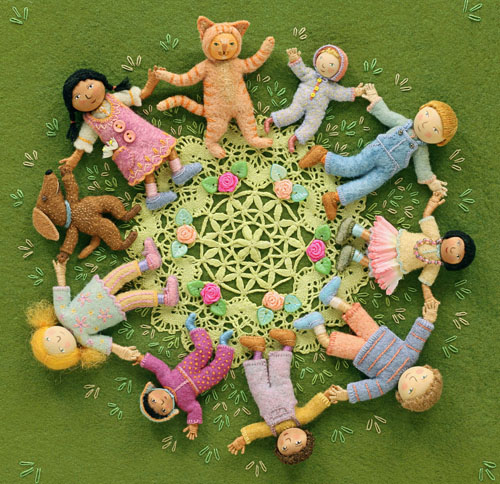
Without further ado, here’s Salley. I thank her for stopping by.
Note: When possible in this interview, I linked book titles to Salley’s local children’s bookstore, Eight Cousins, in Falmouth, Massachusetts. They sell autographed copies of her books. They can be reached at www.eightcousins.com and (508) 548-5548, should anyone want their contact info.
Jules: Are you an illustrator or author/illustrator?
Salley: Illustrator of picture books for young children. My books also cross over into other markets and are used as resources for fiber artists and needle workers.
My occupation is making things by hand.

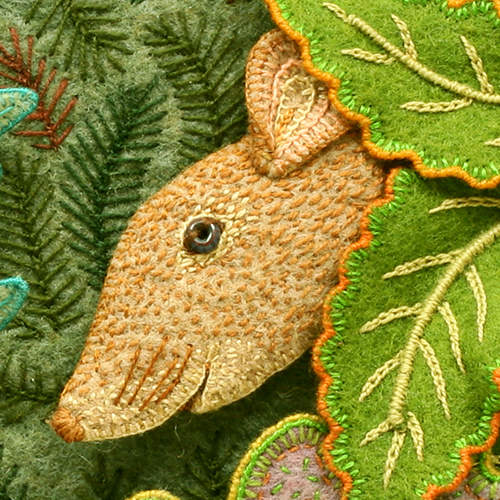
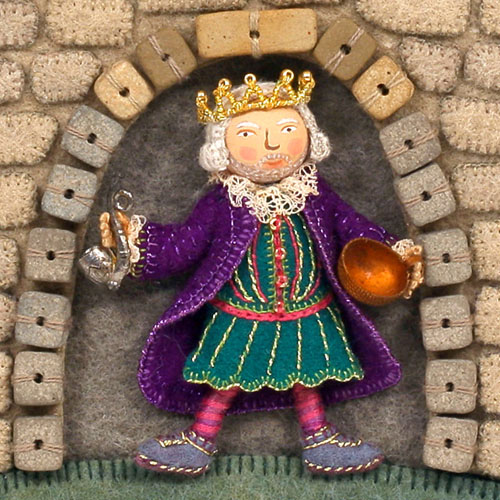
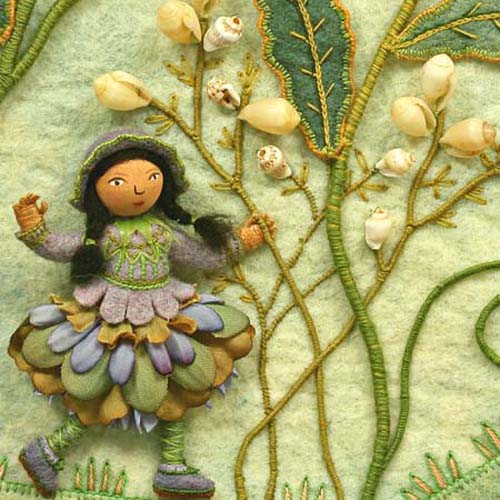
(Houghton Mifflin, 2010)
Jules: Can you list your books-to-date?
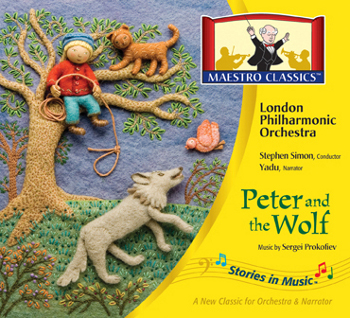 Salley: The Way Home, written by Judith Richardson, 1991; Come to My Party, written by Judith Richardson, 1993; Mary had a Little Lamb, 1995; You and Me: Poems of Friendship, 1997; The Hollyhock Wall, written by Martin Waddell, 1999; In the Heart, written by Ann Turner, 2001; Felt Wee Folk: Enchanting Projects, 2003; Hey, Diddle, Diddle, 2005; Mary Had a Little Lamb (board book version), 2005; Wee Willie Winkie, 2006; Jack and Jill, 2006; Pocketful of Posies: A Treasury of Nursery Rhymes, 2010.
Salley: The Way Home, written by Judith Richardson, 1991; Come to My Party, written by Judith Richardson, 1993; Mary had a Little Lamb, 1995; You and Me: Poems of Friendship, 1997; The Hollyhock Wall, written by Martin Waddell, 1999; In the Heart, written by Ann Turner, 2001; Felt Wee Folk: Enchanting Projects, 2003; Hey, Diddle, Diddle, 2005; Mary Had a Little Lamb (board book version), 2005; Wee Willie Winkie, 2006; Jack and Jill, 2006; Pocketful of Posies: A Treasury of Nursery Rhymes, 2010.
{Ed. Note: Pictured above is Salley’s CD cover art for Maestro Classics’s Peter and the Wolf (2007)}.
As well as illustrating children’s books, I have written a how-to book for adults, Felt Wee Folk: Enchanting Projects. {Images pictured below.} The book gives step-by-step instructions for making little dolls and other items made of felt. For almost ten years, I designed, put together, and sold fairy doll kits through my company, Wee Folk Studio. I discontinued the kits in order to have time to work on Pocketful of Posies.

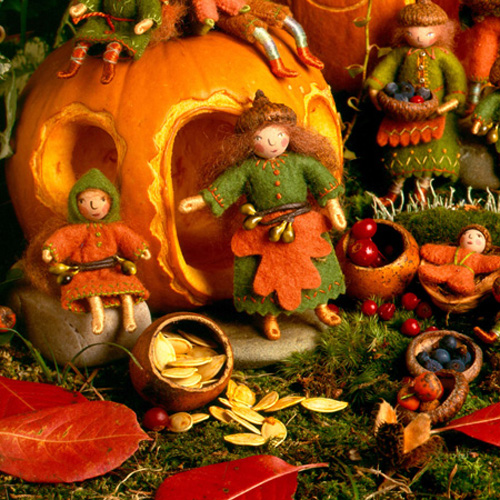
In between book projects, I make pictures for myself, like Self Portrait: A Personal History of Fashion (2007). It’s a spiral timeline of my life, from birth to age 52, with a doll representing each year. My husband and children appear in the years when we are physically bonded, and the older dolls’ hair shows gradual graying.
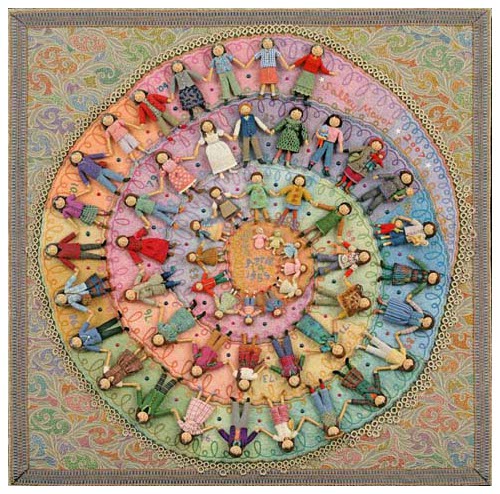
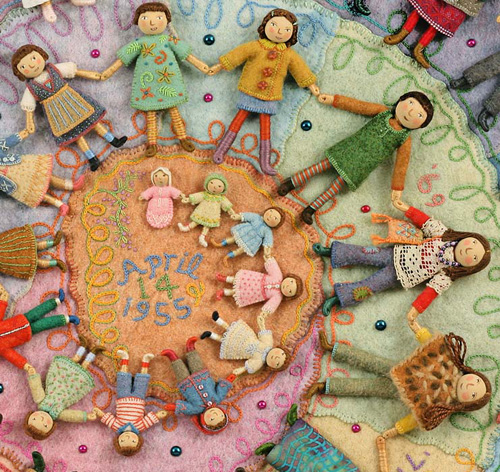
Jules: What is your usual medium, or––if you use a variety—your preferred one?
Salley: Fabric Relief Collage.
I have had a life-long fascination with little things and needlework. Toward the end of art school, I rediscovered my childhood delight in sewing and creating miniature scenes. Leaving traditional mediums like pen and paint behind, but still interested in narrative work, I taught myself stitching and fiber art techniques to use in my illustrations. Manipulating materials in my hands with a needle and thread was so much more satisfying than rendering with a pencil or brush. I found that I could communicate my ideas more clearly this way and that my hands would direct me in a compelling way.
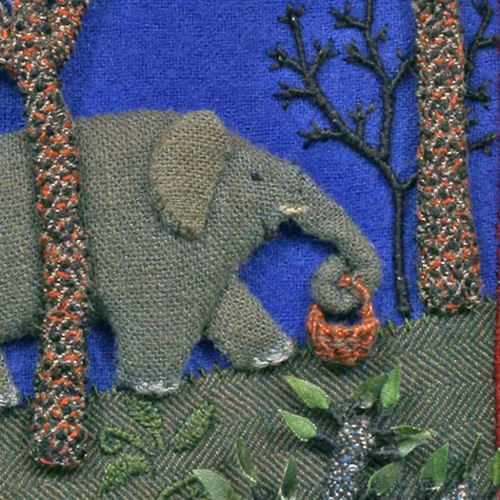
written by Judith Benét Richardson
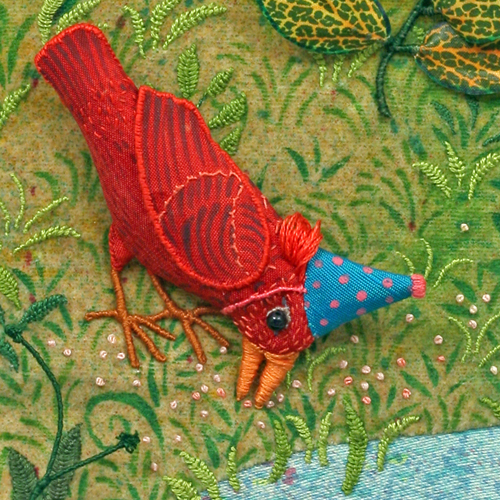
written by Judith Benét Richardson (Macmillan, 1993)
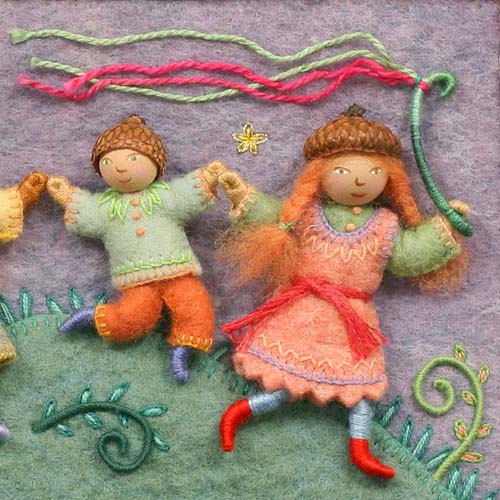
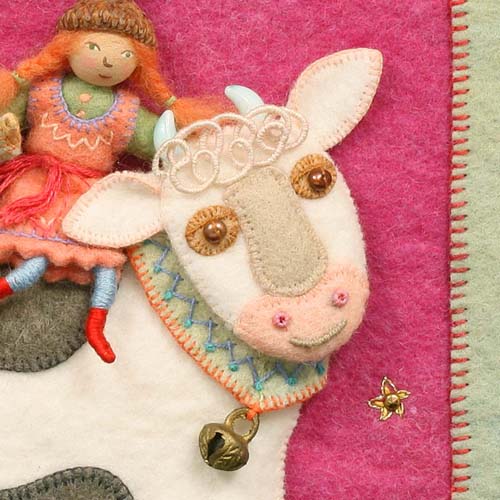
My early pieces were soft sculpture and then turned flatter, with raised figures and objects on a fabric background. I coined the term “fabric relief” early in my career, in 1982, to better describe my evolving method. My three-dimentional pictures resemble miniature, shallow stage sets, with scenery, props and characters telling a story. I embroider, wrap, appliqué, and paint different materials and found objects to create scenes in relief, with figures imposed on an embellished fabric background. My work is decorative and detailed, full of patterns from nature, all sewn by hand. I am self-taught in needle work and have learned through trial and error, as well as plenty of practice. It may be hard to believe, but I’m not as interested in method as I am communication. I just really enjoy sewing and look at my obsession as a healthy activity. I think that in order to best tell a story, my artwork must be executed with skill, so that the medium contributes to the message and doesn’t distract.
Jules: Where are your stompin’ grounds?
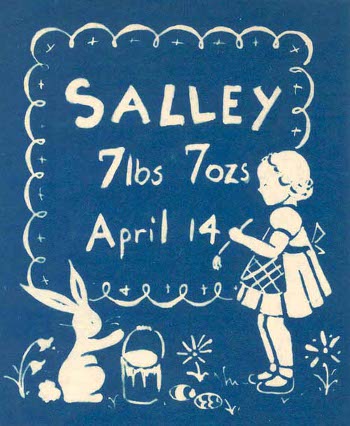 Salley: Born in Boston, 4/14/55. Grew up in Woods Hole, MA. I now live 4 miles away in Falmouth, MA (Cape Cod). {Ed. Note: Salley’s birth announcement—created by her mother, Mary Mavor—is pictured here.}
Salley: Born in Boston, 4/14/55. Grew up in Woods Hole, MA. I now live 4 miles away in Falmouth, MA (Cape Cod). {Ed. Note: Salley’s birth announcement—created by her mother, Mary Mavor—is pictured here.}
The middle of three children, I lived with my parents, sister, and brother in the small village of Woods Hole, Massachusetts, on Cape Cod. Growing up in our household was like living in a busy hive — with art projects, materials, and equipment close at hand. My mother had a big influence on my development as an artist. There was always time for art and I never heard her say no to an imaginative scheme. She would help us gather supplies and teach us whatever we needed to make an idea come to life. We lived in a perpetual state of clutter, with the technique du jour in evidence all through the house. One day, Mom had the children clear a path through the living room so that our father could walk through.
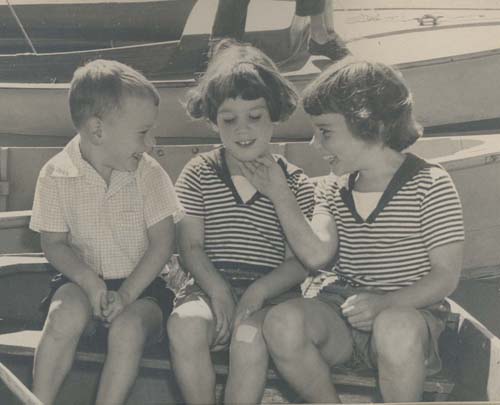
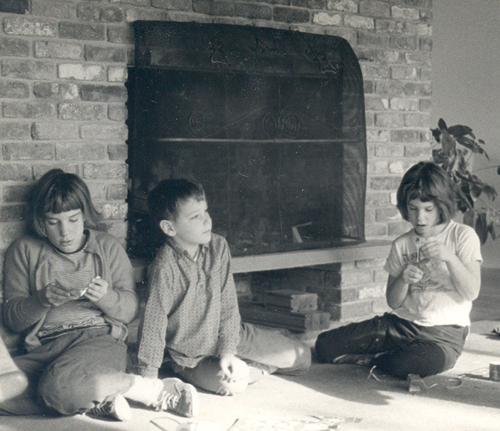
For Mom, part of the fun of making things was the physical thrill of interacting with the materials. Her batik room was a Jackson Pollack of spattered dye, where she would busily apply hot wax on the fabric and dip it in dye pots. Our world was full of creative possibilities, and I’ve dedicated Pocketful of Posies to the memory of my remarkable parents, Mary and Jim Mavor.
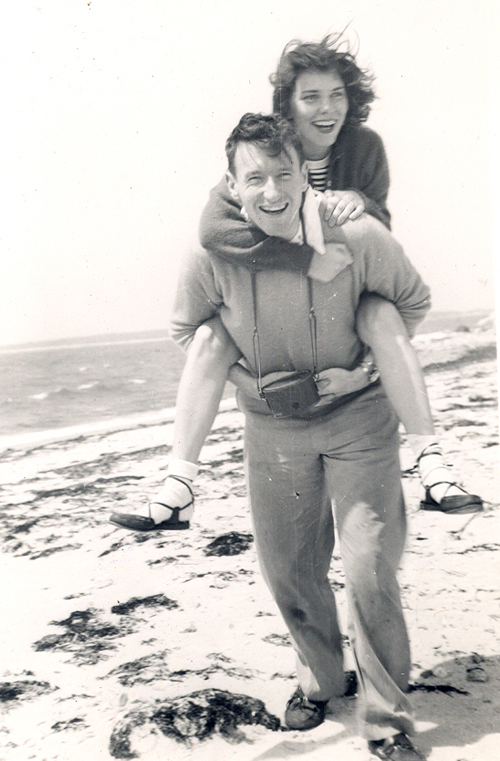
Jules: Can you tell me about your road to publication?
Salley: I became an illustrator kind of by accident. I’ve known since a young age that art was my “thing,” but I didn’t imagine a career in illustration. All of the books I enjoyed as a child were drawn or painted and, although I loved to draw, I was more attracted to working in three dimensions. Crayons and paint were never enough for me and I had (and continue to have) the urge to sew, staple, or glue real things to my pictures. I can remember lying on my living room floor looking up at all of the objects around me and having the thought that all of these things—furniture, lamps, rugs, curtains—were some form of art. “Someone designed all of this,” I marveled. Art wasn’t just a framed painting on the wall. It was snowing outside, and I imagined nature as an artist, too, making beautiful snowflake designs.
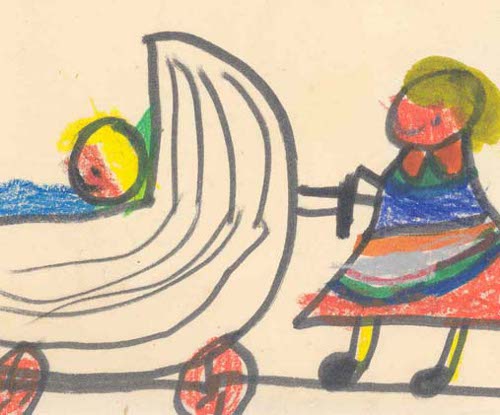

For the past 20 years, I’ve been working in the field of illustration, making artwork which is photographed and printed in children’s books. It took about ten years to develop a technique to the point where I felt confident enough to illustrate a picture book. I continue to experiment with different materials and methods until I find a compatible combination that translates the ideas and pictures in my mind into something tangible. After my work is photographed for use as illustrations, the original pieces are mounted on stretched fabric and framed under glass in shadow boxes, ready to show and sell as individual pictures. The original fabric reliefs collages from my newest book, Pocketful of Posies, are touring around the country for three years and are currently on display at the Danforth Museum in Framingham, MA.
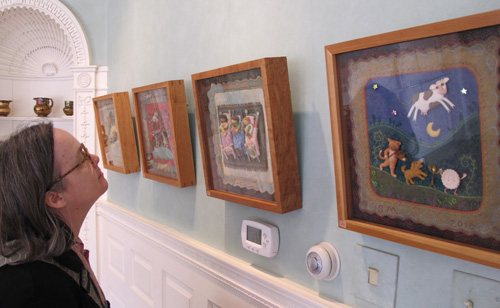
Looking back, I have early memories of sewing and constructing things as a child. I would spend hours sewing outfits and creating scenes for my dolls. Once I figured out how to sew on snaps, a world of possibilities opened up. I was especially interested in all things miniature and coming up with ways to decorate and furnish my dolls’ environment. I can remember making a tiny bathroom and looking around the house for shower curtain material. It had to be plastic and water repellent; regular cloth would not do! I took a pair of scissors, went into our bathroom, and cut a small piece out of the shower curtain. It took a while for my mother to discover that the corner was cut out, but she was quite open to sacrifice in the name of art. She was an artist herself and created an atmosphere in our home where art and making things with one’s hands was important. In our home, learning how to make things was not only looked upon as fun, but there was also an unspoken high regard for handwork and beauty. Art was not looked upon as an “extra” and my mother instinctively knew the benefits of creative work, that the process can engage the physical, mental, emotional, and spiritual parts of oneself.

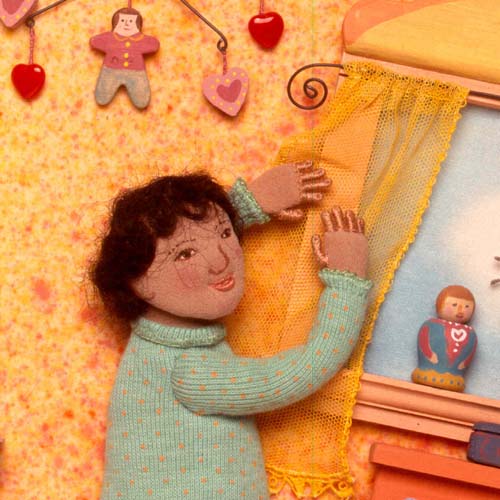

(HarperCollins, 2001)
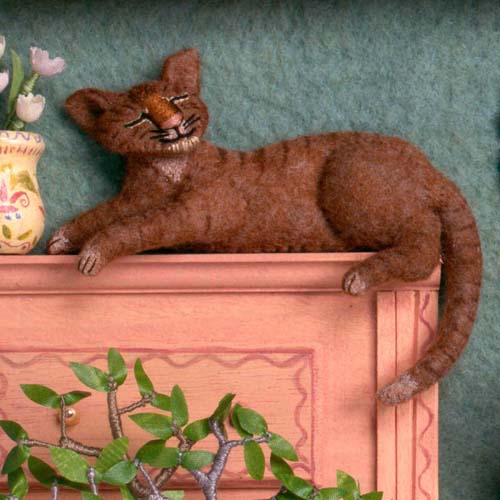
In a term paper about art education for her master’s degree in 1965, my mother wrote, “The student should be encouraged to find his own way, but this does not mean the void of laissez-faire. Children need a structured exposure to many ways of seeing, doing, and thinking. To teach art, the teacher must be an artist. By having confidence in their own abilities, teachers will be able to sensitize children to want to learn and care—not just problem solve. Through intuitive discovery a child will find himself, what he believes and be really free, even in a computer society. By giving students something to do—learn and contemplate what they can understand naturally—will give them the values needed today.”
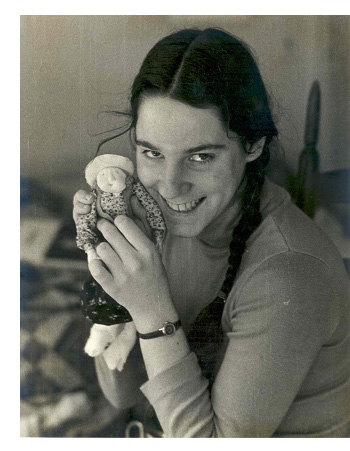 Years later, in art school, I rediscovered my childhood fascination with working in three dimensions. I majored in illustration, but I never thought I’d make actual illustrations that could be reproduced effectively and used commercially. At the Rhode Island School of Design during the 1970s, there wasn’t an obvious major for someone like me, who was interested in many different materials and methods. I didn’t want to limit myself to a particular discipline and was attracted to the illustration department, with its focus on communication, rather than certain processes and mediums. Just as other schools are divided by subject, our student body was separated by technique and I regret not mingling with people in other majors. Other possible matches, like the sculpture or textile department, were too specialized for me.
Years later, in art school, I rediscovered my childhood fascination with working in three dimensions. I majored in illustration, but I never thought I’d make actual illustrations that could be reproduced effectively and used commercially. At the Rhode Island School of Design during the 1970s, there wasn’t an obvious major for someone like me, who was interested in many different materials and methods. I didn’t want to limit myself to a particular discipline and was attracted to the illustration department, with its focus on communication, rather than certain processes and mediums. Just as other schools are divided by subject, our student body was separated by technique and I regret not mingling with people in other majors. Other possible matches, like the sculpture or textile department, were too specialized for me.
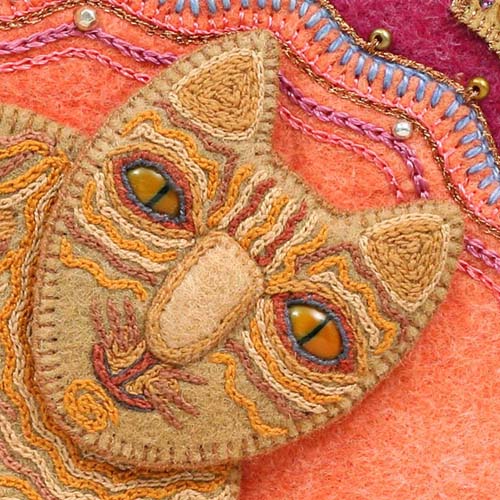

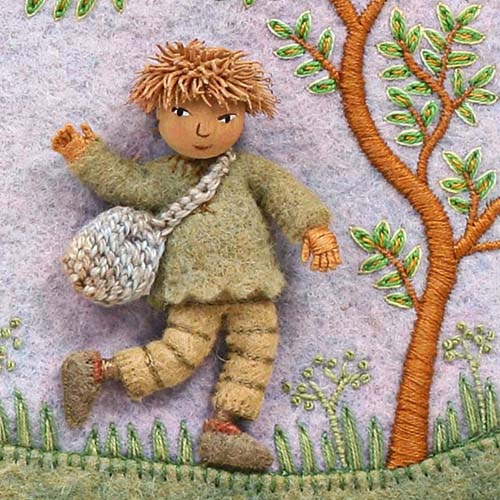
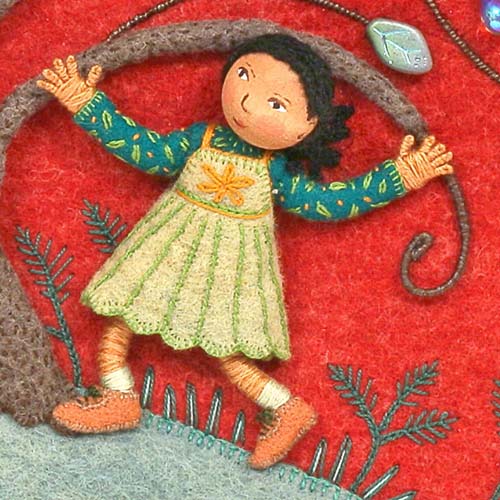
(Houghton Mifflin, 2010)
At RISD, the sculpture department seemed to me like an all boys’ club, with its swarm of black clad, chain-smoking young men who produced large, austere metal sculptures, the kind that are now rusting in public places. Even the more female-dominated textile department, with its concentration on fabric design and weaving, was too narrow for me. All I knew was that total abstraction left me hungry for more and I wanted my artwork to be a kind of narrative that viewers could connect to — but wasn’t too cutesy or superficial. In the illustration department, I could use any materials I wanted, as long as my artwork solved the assignment. I used this time in school to teach myself different ways of working and showed an overwhelming interest in fabric and sewing. I’ve never taken a class in any kind of fiber art or sewing (accept for 4H class in my childhood). I don’t think I would have made a very cooperative embroidery student, given my tendency to resist conformity and an urge to “color outside of the lines.” I just figured out stitches by looking at diagrams and sewing an obsessive amount.
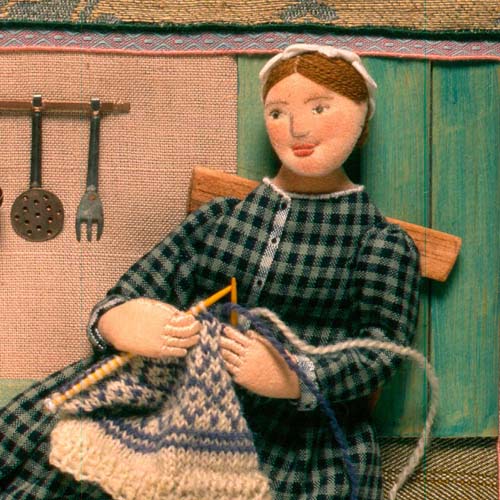
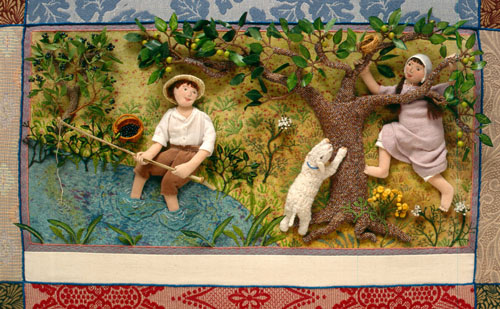
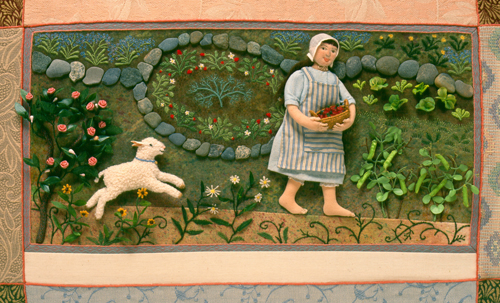

While a student, I started making and selling a line of fabric pins. One day during class, I was listening to a critique, sewing some peapods, when my teacher, Judy Sue Goodwin-Sturges, noticed what I was doing. She looked more closely, asked me a few questions and said, “Why don’t you do this kind of thing for your illustrations? Try sewing them.” With that simple encouragement, I stopped trying so hard to communicate the pictures in my imagination through a brush or pen. Given permission to work outside of the usual illustration mediums, I found that I was much happier and energized. I was no longer struggling to keep in step, but with a needle and thread I could dance. For some reason, I’d been under the impression that in art school, one does “serious” fine art and I’d kept my interest in sewing and handcrafts underground. I rediscovered the joy of creating and learned to trust my hands and gut feelings to help work out challenges.
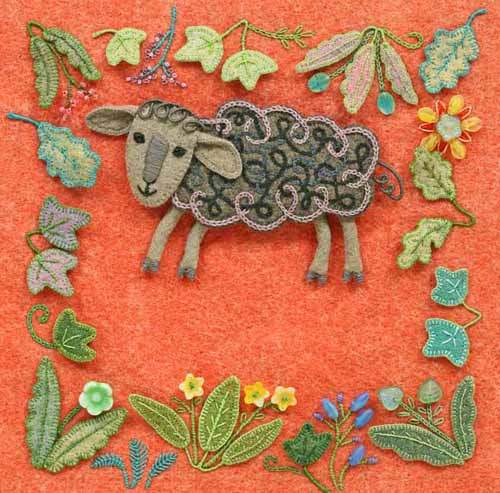

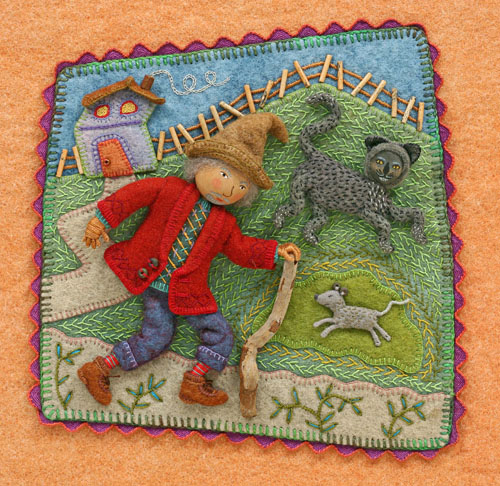
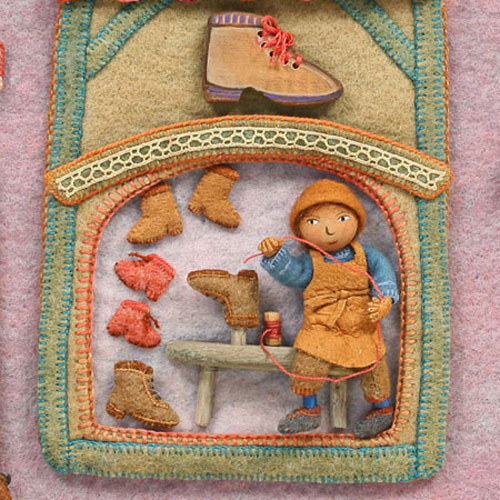
(Houghton Mifflin, 2010)
Jules: Can you please point readers to your web site and/or blog?
Salley: Website: www.weefolkstudio.com. Blog: weefolk.wordpress.com.
When I fell off a ladder and broke my wrist this past January and could not stitch, I was desperate to find a substitute to keep myself occupied. Fortunately, a few months earlier, I had started a blog. I couldn’t sew, but I could type little stories with one hand and add photos to go with them. Over several months of recuperation, I transferred my creative energy to composing blog posts. I became keenly aware of how my sense of well-being is linked to being involved in some sort of creative activity on a daily basis. During the winter, I reflected on my career and wrote blog posts about my artistic development and influences. It is rewarding to hear from readers who know of my work through my books and to know that people are interested in what I have to show and say.
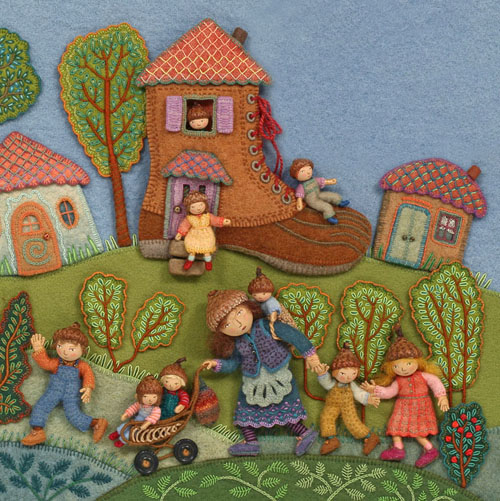
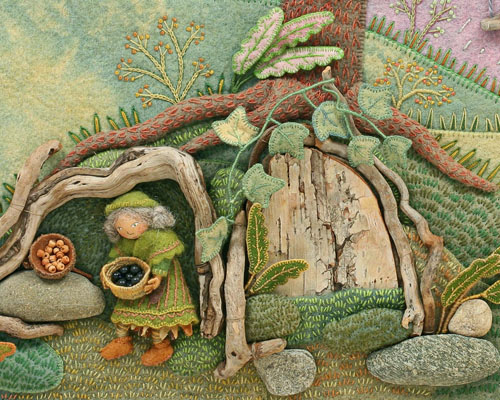
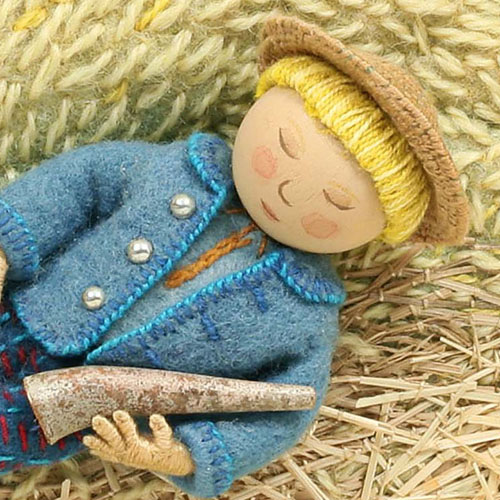

(Houghton Mifflin, 2010)
Jules: What exactly is your process when you are illustrating a book? You can start wherever you’d like when answering: getting initial ideas, starting to illustrate, or even what it’s like under deadline, etc. Do you outline a great deal of the book before you illustrate or just let your muse lead you on and see where you end up?
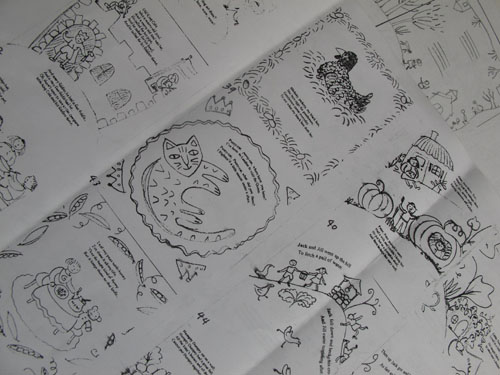


Salley: When working on a book, I first make drawings and layouts of the book’s pages. They are pretty basic; the detail comes later when I start sewing. After my sketches are approved by my editor, I have a lot of freedom to use any materials I wish. It takes between 1½ years and 3 years to illustrate a book. The finished fabric relief pictures are photographed and printed in the book.
When I’m stitching and manipulating materials and the process is going well, I almost feel transported into the world I’m creating. It’s a refuge from the chaos around me and a way to gain control of something in my life, even if for a short while. Working with a needle and thread is therapeutic and I can easily spend a whole day making one little prop, like a miniature basket out of coiled wire and embroidery floss.
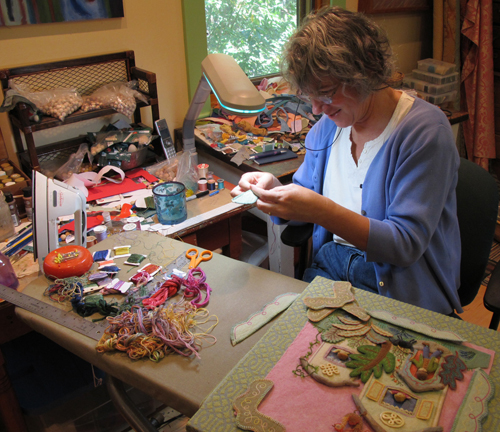
One of my favorite activities is sifting through piles of fabric and drawers full of beads, charms, and interesting tiny natural or man-made objects I’ve collected over the years. Each new piece has its own unique challenges to work out during the process, and I let my hands take the lead. Instinct, as well as careful observation, plays a big part in selecting found objects to use. Since each page in Pocketful of Posies illustrated a different rhyme, I was free to add one-of-a-kind items from nature, such as curvy pieces of driftwood.

I didn’t have to repeat characters and show a consistent environment (as is usual for a story book) and felt liberated. I could bring into play a more eclectic combination of materials, without worrying about finding matching items of a different scale.
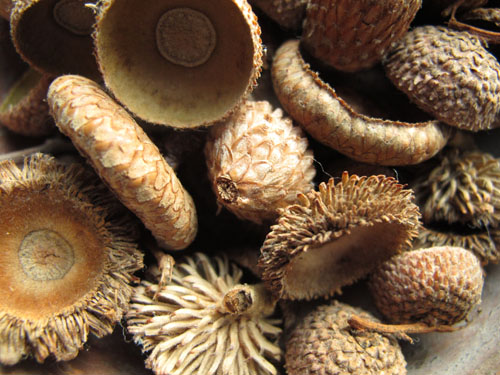

Jules: Describe your studio or usual work space.
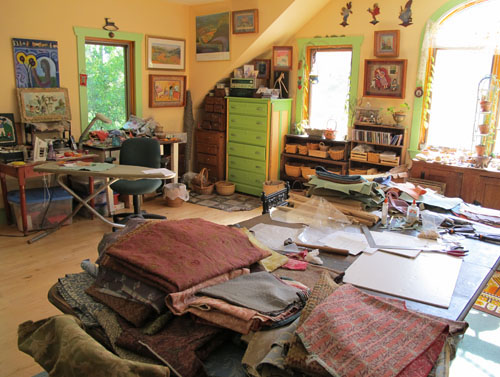
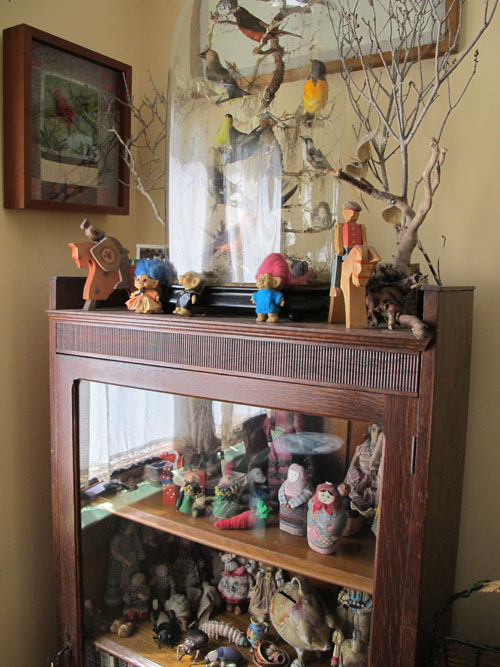
Salley: I work in a studio above our garage. I don’t need much room to actually work, but I need lots of room to store and display all of my stuff. I like to be surrounded by treasures, either man-made or from nature. I also have boxes and drawers full of found objects that I use in my artwork.

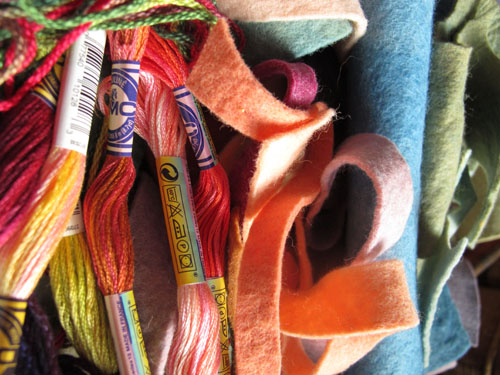
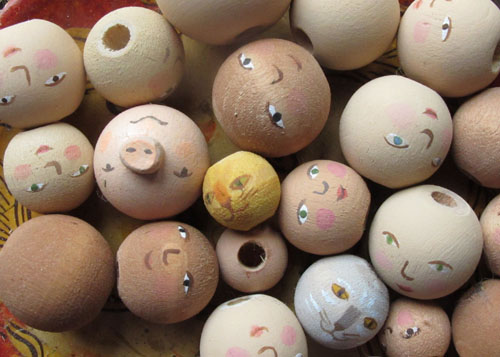
Jules: As a book lover, it interests me: What books or authors and/or illustrators influenced you as an early reader?
Salley: I remember really loving Alice and Martin Provensen’s books and still do.
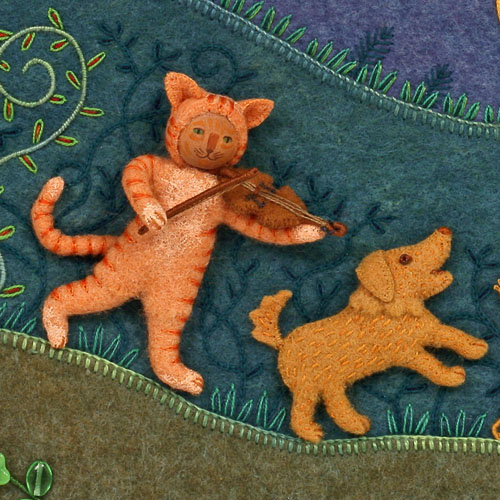
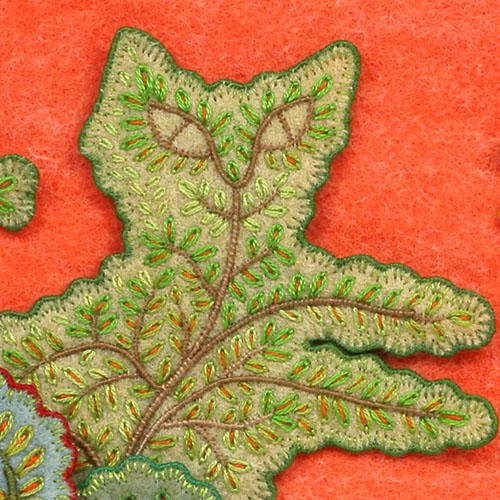
And what do you think / It was all about?”
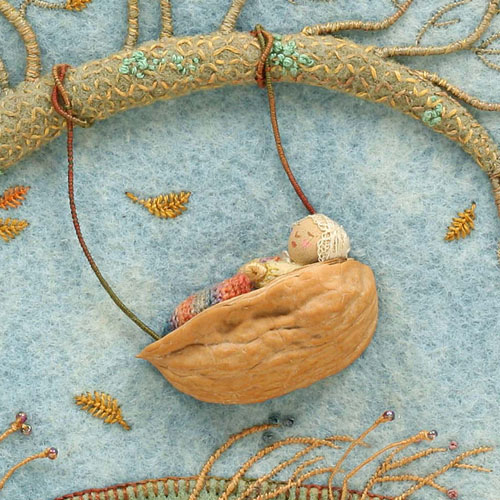
(Houghton Mifflin, 2010)
Jules: What is currently in rotation on your iPod or loaded in your CD player? Do you listen to music while you create books?
Salley: I listen to music when I work. Right now there are Natalie Merchant, Mark Knopfler, Patty Griffin, and Elizabeth Edwards CDs in my CD player.
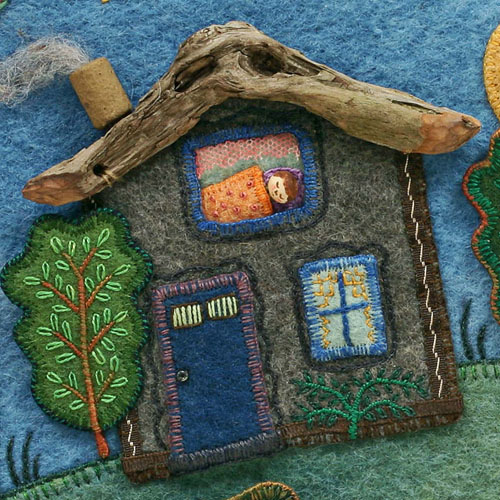

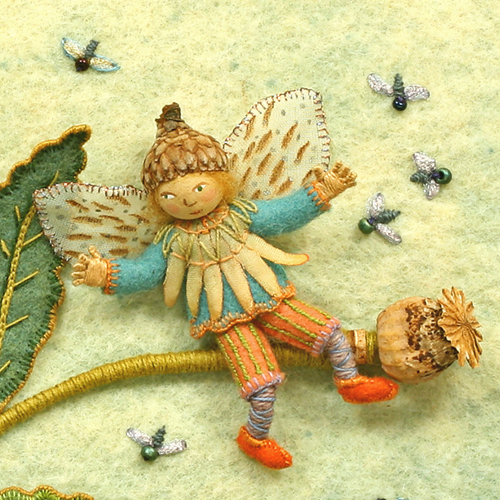
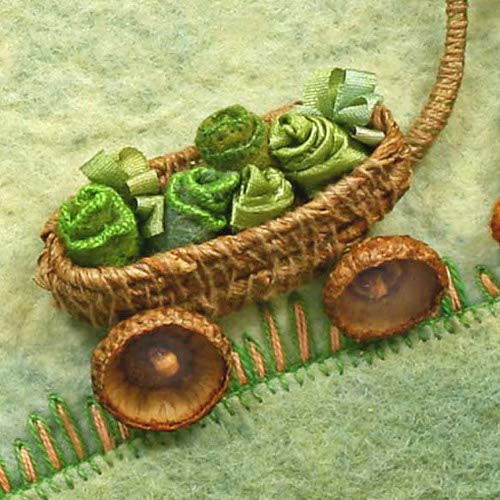
(Houghton Mifflin, 2010)
Jules: What’s one thing that most people don’t know about you?
Salley: I really love to dance and sing. If I weren’t so introverted, I could have been a performer.
Jules: Any new titles/projects you might be working on now that you can tell me about?
Salley: I am planning on taking a break from illustration and making more personal artwork. I’ll still work in three dimensions and stitch like crazy, but lately my muse has been calling and urging me to try a new approach. I’m not sure what I’ll be doing, but I figure that if I’m going to expand my horizons, now is the time.
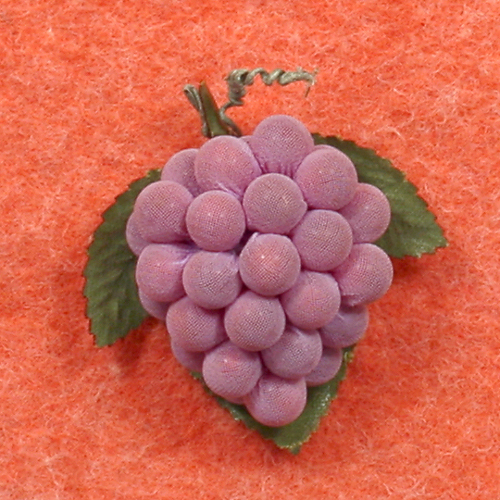
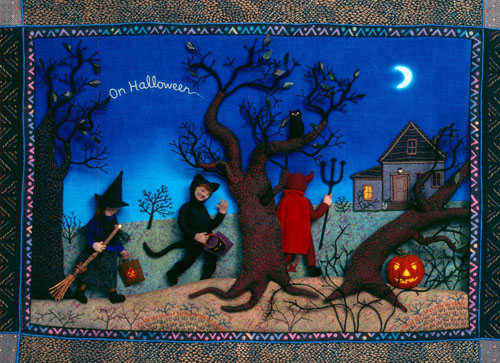
All artwork and photos used with permission of Salley Mavor. All rights reserved.
(these interviews will be linked as they go live):
Monday, December 6:
- Elizabeth Hand at Chasing Ray
- Maya Gold at Bildungsroman
- L.K. Madigan at Writing & Ruminating
- Paolo Bacigalupi at A Chair, A Fireplace & A Tea Cozy
- R.J. Anderson at Hip Writer Mama
Tuesday, December 7:
- B.A. Binns at The Happy Nappy Bookseller
- Daisy Whitney at Bildungsroman
- Adam Gidwitz at A Fuse #8 Production
- Josh Berk at Finding Wonderland
Wednesday, December 8:
- Andrea Seigel at Shaken & Stirred
- Adele Griffin at Bildungsroman
- Susan Campbell Bartoletti at Chasing Ray
- Charles Benoit at A Chair, A Fireplace & A Tea Cozy
- Sarah MacLean at Writing & Ruminating
- Allen Zadoff at Hip Writer Mama
Thursday, December 9:
- Kathi Appelt at Shelf Elf
- Heidi Ayarbe at The Happy Nappy Bookseller
- Julia DeVillers and Jennifer Roy at Bildungsroman
- LeUyen Pham at Finding Wonderland
- Paula Yoo at Hip Writer Mama
Friday, December 10:

Wow. These are AMAZING.
*off to request all of Salley Mavor’s books now*
[…] at The Happy Nappy Bookseller Daisy Whitney at Bildungsroman Adam Gidwitz at A Fuse #8 Production Salley Mavor at Seven Impossible Things Before Breakfast Josh Berk at Finding […]
The next post in this blog is How much does a 12 yd skip cost. Classic Fiction Books
Stunning, from start to finish. This is just a wonderful interview, Jules. Thanks so much!
[…] The Happy Nappy Bookseller Daisy Whitney at Bildungsroman Adam Gidwitz at Fuse #8 Salley Mavor at Seven Impossible Things Before Breakfast Josh Berk at Finding […]
Unbelievably beautiful and amazing! WOW!
*going to order all her books now*
Thanks so much, Jules and Salley!!
AMAZING work! Thanks for this, Jules.
It wouldn’t be that hyperbolic to say that I am Salley Mavor’s biggest fan, except I know that there are a good deal of us jostling for that position. Thanks for this interview, Jules, and for introducing Mavor’s work to more people.
–Farida
Thanks, all.
Farida, if she saw your work, she’d likely be a fan of yours, too.
WOW – just WOW! 🙂
Lovely, lovely. I haven’t seen Posies yet, but now I have it on order. Salley’s Mary Had a Little Lamb is a particular favorite of mine.
Holy WOW! This is amazing work. In fact, my husband is going to post a link to this interview for his art appreciation classes.
Farida–I’m so not surprised you’re a fan. 🙂
Apropos of nothing, it seems like all the awesome artists went to RISD…sigh.
I just bought Pocketful of Posies for my great-nephew’s Christmas present, but I think I’m going to have to buy him another copy. I was purring as I read it. And this interview: wonderful! My husband asked if I wanted to go to the show at the Danforth, and I wondered if it would be too much to be among people whispering “oh my gosh!” which I do at every sweet face and stitch, but I think I have to join those lucky folks. Thank you both!
Well, I didn’t get to this post until just before dinner and I’m so glad I did. Your art is as rich and detailed as the life journey you shared. Thank you so much, Salley and Jules.
Love the textural, colorful, whimsical illustrations AND Salle’s studio full of fabrics and found stuff AND since I was born within months of Ms. Mavor I’ve pretty much lived that fashion wheel!
What a fun post. Thanks Salley. Thanks Jules.
[…] Salley Mavor at Seven Impossible Things […]
[…] Salley Mavor at Seven Impossible Things […]
Add me to the list of people jostling to be Salley Mavor’s biggest fan! All her work is stunning, but this book looks to be her piece de resistance. I have my fingers crossed for an autographed copy for Christmas!
I can’t close the browser window! My eyes are addicted, help!
Thank you so much for this interview. Touched me on so many levels. As a fellow illustrator, I loved seeing the planning that goes into the intricacies of Sally’s painstaking artwork. As a mother of two little girls, I loved reading about how whe was raised in such a creative household where making things was part of life – I’m trying to provide that for my own family and it’s great to see where the power of creativity can take you.
Thanks so very much!
so inspiring! I want to drop what I’m doing and go buy embroidery thread. Thank you for a wonderful treat.
Amazing work! The technique is mind-boggling for sure. But the design, the imagery, the harmonies are all so wonderful. What an artist! Thank you.
[…] reminder: To see this week’s Winter Blog Blast Tour schedule, it is posted here. Scroll down to the bottom of that post. I’m updating the interview links as they go […]
I am totally in love. What beautiful work! Now I know where I’m going to be going soon…the Danforth Museum. This is such a treat. Thank you so much!
This was such a joy to see – my daughter and I crazy crazy crazy love Salley’s work and it was wonderful to read her words – many thanks!!!
AMAZING! Can’t wait to show my kids…
oh my, be still my beating heart.
As a lover of detail I am transfixed and smitten,
so wonderful and lovely, delightful and surprising and darling!
The world is better for Salley Mavor being in it!
Thank you.
W
Really wonderful work. Her studio is like something out of a incredible dream with all kinds of wonderful treasures.
I am absolutely bowled over – thank you for this wonderful interview, with so many gorgeous photographs. I love the blend of exquisite embroidery and bits of nature, and such sweet faces too. Imagine having the talent to create a self-portrait like that!
Thank you for a truly wonderful post! With such luscious pictures it was the absolute best eye candy. The word that always comes to mind when I see Salley;s work is “delicious.” And, like the best sweets, I can never get enough!
what a wonderful glimpse into an artist’s inner and outer wonderland. Perfectly beautiful handwork!!!Thanks, Jules and thanks Salley!
[…] Illustrator / Maker-of-Things-By-Hand Extraordinaire Salley Mavor (December 7, 2010): […]
I was first introduced to Salley Mavor’s rich and creative handwork by author/ illustrator Maggie Smith when she joined our illustrators group and saw that I was working with textile collage.
I became an instant fan and was so delighted to hear that Salley had been chosen as the SCBWI Golden Kite illustrator’s award winner for 2011.
There is still a certain resistance to textile and embroidery art which I hope this award will help to overcome.
What a child’s dreamland of artistic expression! Your creations are over-whelmingly exquisit!
We are committed fans…
[…] Such good choices, and I’m particularly happy to see Salley Mavor win for Picture Book! (Here’s my December 2010 interview with her for fellow fans to read and […]
Stumbled upon your work while surfing the web…and what can I say…you have touched a part of my heart with your Awesome work. My family is gathered around my Mac and we are all totally amazed. We love your work, and the info on your life! Keep t up….You are blessed!
Thanks…I am putting a link to your work on Facebook.
All the best.
Peace,
Roby
Great website. Lots of helpful info here. I’m sending it to a few friends ans also sharing in delicious. And naturally, thank you on your sweat!
[…] And read a 2010 interview (that’s when this book was published), plus see beautiful details of her work at Seven Impossible Things. […]
I saw this on Facebook too. I’m so glad to be directed here. So inspiring. I’ve always wanted to use more sewing with my clients. I can see possibilities here. Thank you so much.
[…] Salley Mavor’s autobiography by needle. Her life cycle – one figure for every year. […]
[…] Debut author B.A. Binns @ The Happy Nappy BooksellerSuperhero Daisy Whitney @ Bildungsroman,The spookyfun Grimm Adam Gidwitz @ Fuse Number 8Artastic Salley Mavor @ Seven Impossible Things Before Breakfast. […]
[…] this opportunity to add an extra dash of charm and character to your Elf on the Shelf by exploring the fascinating world of Elf on the Shelf stories, and relish in the joy of watching your creation become an integral part of this cherished holiday […]